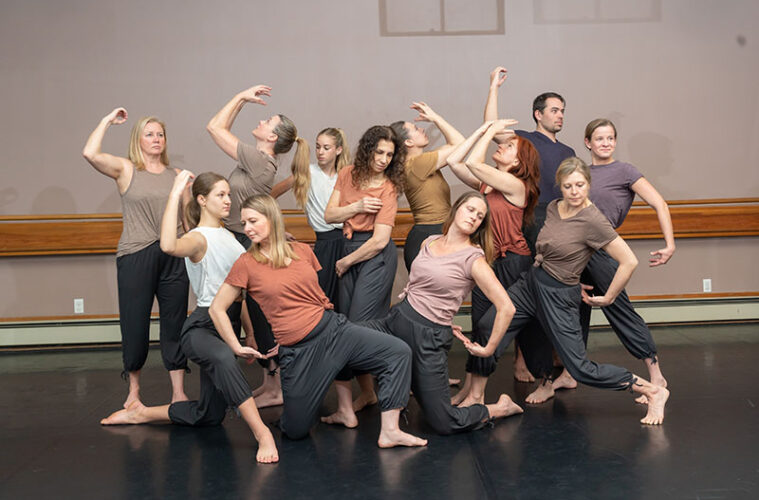Even in stillness, there is tension. A dozen or so members of Exit Dance Theater are frozen in various poses—some with hands out straight, some with arms akimbo, and the air is electric with the possibility of what comes next. A moment later, they are in movement again, each bringing their own gestures and footwork yet somehow creating an impression of harmony overall.

When the music stops, the discussion begins. Foot movements, the way one dancer lifts another off the ground, the fluidity of a gesture, head position—all are up for analysis, with Stephen Haley, who is choreographing the piece, weighing in with thoughts and instructions.
“Remember, you are not just a dancer,” Haley, who is a founding member of the company, advises the group. “You are a character. Start dreaming about that.”
That has been the mantra of Exit Dance Theater for more than 35 years. Originally launched in 1987, the Newburyport company focuses on extending dance beyond the physicality of movement into storytelling.
“Our work isn’t concert dance, which is more like a modern ballet,” says Fontaine Dubus, co-artistic director and another of the original founders. Instead, Dubus says, Exit Dance is dedicated to improvisation and collaboration, yielding an artistic freedom that has perhaps been the glue that has kept the company together for decades. At minimum, the 16 members have been dancing together for more than ten years, with four of the founding members—Dubus, Haley, Susan Atwood, and Cheryl Fisher—still in the troupe.
“When you have dancers at this level, especially when they have been working together for so long, they instinctively know how to fill the space,” Haley says, noting that camaraderie also leads to the group’s feeling safe to explore profound emotion. “There is a narrative aspect to our work that is deeply meshed in emotion. We’re not interested in spectacular, virtuoso-type technique. What we’re after is the meaning inherent in the images, in the movement and in the pieces themselves.” Most performances go through a series of iterations, starting with improvising on a theme until the work starts to come together into a whole, telling a story through movement.

“We are really unorthodox in that way,” Dubus says, noting that while there are times when a member arrives with a piece already choreographed, it’s more the norm for dances to develop organically. “It’s very normal for us to start out . . . playing music and watching the dancers improvise, then using that movement as part of the set choreography. That’s where we are different from a lot of companies. I want to see what comes naturally to my dancers.”
To build the new show debuting in May, “Syntropy Disrupted,” the company began exploring themes and ideas back in September. Dubus, the choreographer for a work entitled “Beautiful Sleep,” was inspired by a collection of Italian musical pieces and built her work around them.
Haley’s work, “The Garrett,” followed a much more exploratory path, continuing to evolve over time. Exploring different music and themes, it developed from an idea about choice in the post–Roe v. Wade era into a piece in six movements deeply influenced by the feminist philosopher Simone Weil and the writings of Plato. The spare stage for Haley’s piece features just three window frames, suspended from the ceiling, and relies on sophisticated lighting to create the feeling of a garret or Plato’s cave. “We’re playing with notions of, ultimately, what does it mean to be an individual and yet at the same time be part of a collective,” Haley says.
That’s an apt description of the company’s mission, where the hope is to bring the audience into the process. Many people attend a performance because they love movement or dance, but Exit Dance Theater members want spectators to come away with much more—an unexpected narrative arc.
“Oftentimes, there are two things our audience takes away from a performance,” Haley says, “the power of the image itself—that is whatever they actually saw us do—and then the power of the feeling we brought to what we did. Some folks have very intense emotional experiences, based on the work.”
Really, it’s that journey that the company is reaching for, translating nine months of artistic exploration into a brief time on stage. “As much as we have need for food, relationship, work, and shelter, we have a need for creativity,” Haley says. “In the absence of that creativity, a portion of our humanity is diminished. It’s this creative instinct that ultimately bonds us to what we’re doing.”

